
Both Hyundai and Kia recently announced voluntary adjustments to fuel economy estimates on several models ranging from the 2011-13 model year. In addition to the fuel efficiency ratings corrections, both automakers plan to compensate buyers for the difference.
Fuel economy estimates are a funny thing. We often hear anecdotally how many automakers’ fuel economy estimates are overreaching, especially as fuel economy standards increase. Customers frequently wonder how such numbers are generated and how they can be so inaccurate.
Trying to concisely explain how automakers and the EPA come up with fuel economy figures is just like trying to explain torque; it virtually can’t be done. That’s why it comes as no surprise that the smoke and mirrors that is fuel economy estimates has proven a liability for a two major automakers: Hyundai and Kia.
Owned by the same parent corporation and sharing drivetrain research and design facilities, Hyundai and Kia face a daunting predicament: Around 900,000 (35 percent of total sales) of the vehicles sold over a two-year period were branded with incorrect fuel economy estimates.
On average, the fuel efficiency numbers listed on the window sticker of various Hyundai and Kia models — often the numbers that drew customers to the showrooms in the first place — were three-percent too high.
The mistake, the manufactures claim, originated in procedural errors during the “coastdown” process of fuel-economy testing. Simulating wind resistance, rolling resistance, and drivetrain frictional loss, coastdown results affect the programming of test dynamometers that generate EPA fuel economy ratings.
Both Kia and Hyundai are eager to make things right. Customers who purchased an affected model will be issued a personalized debit card, reimbursing the customer for the difference between the advertised fuel economy and the adjusted numbers — plus 15 percent for good measure. The amount put onto the debit account will be based upon the model, miles driven, and the fuel prices in the customer’s location.
Current owners will receive compensation funds dating from original purchase, on going throughout ownership. Customers who purchased one of the affected models but who has already sold the vehicle will still receive a debit card reimbursement for their ownership period.
If you’d like to know more about the reimbursement program and see a list of eligible vehicles, go to: www.HyundaiMPGinfo.com and www.KiaMPGinfo.com.
While this slip-up is unfortunate, we’re glad to see both automakers stepping up to do what’s right for their customers. Additionally, we hope other automakers learn a lesson from the Korean manufacturers.


